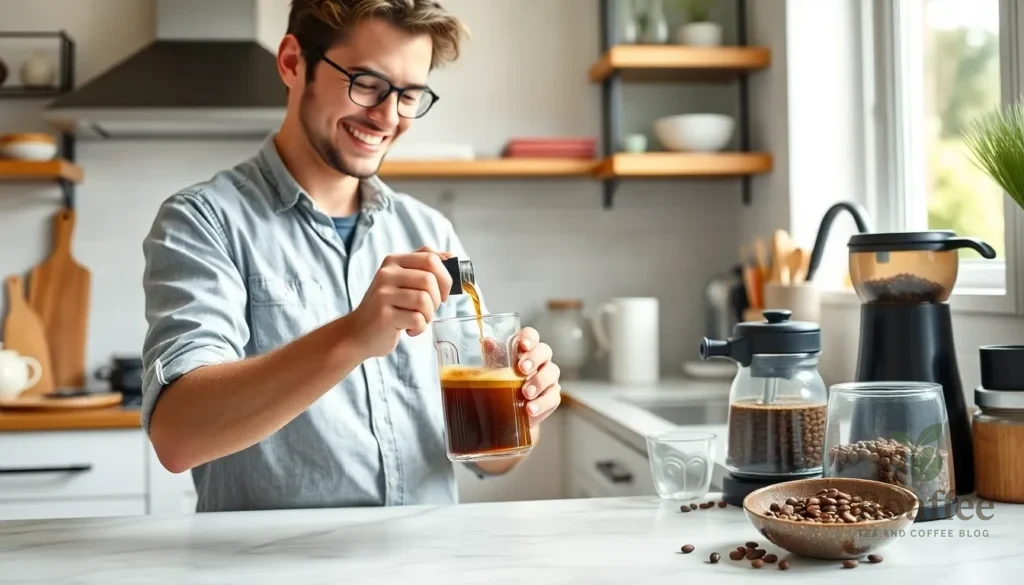We’ve discovered the secret to never running out of delicious coffee again – and it’s simpler than you think. Coffee concentrate is a game-changing brewing method that delivers rich, bold flavor while saving you precious time during busy mornings. This liquid gold can be stored in your refrigerator for weeks and transformed into hot coffee, iced drinks, or even used in baking recipes.
Making coffee concentrate at home isn’t just cost-effective – it’s incredibly versatile. Whether you’re craving a quick cup before work or hosting friends for brunch, this concentrated brew adapts to any situation. We’ll show you how to create the perfect ratio that produces smooth, never-bitter coffee every single time.
The best part? You probably already have everything you need in your kitchen right now. No expensive equipment required – just coffee grounds, water, and a little patience. Let’s jump into this foolproof method that’ll revolutionize your daily coffee routine.
What Is Coffee Concentrate
Coffee concentrate is a highly concentrated liquid coffee extract that contains significantly more caffeine and flavor compounds than regular brewed coffee. We create this potent solution by using a higher coffee-to-water ratio than traditional brewing methods, typically ranging from 1:4 to 1:8 depending on desired strength.
This concentrated form allows us to store large quantities of coffee essence in minimal refrigerator space. The process involves steeping coarsely ground coffee beans in room temperature or cold water for extended periods, usually 12 to 24 hours. Cold brewing naturally reduces acidity and bitterness while extracting maximum flavor compounds.
We can dilute coffee concentrate with hot water, cold water, milk, or cream to achieve our preferred strength and taste profile. The versatility extends beyond beverages as we incorporate it into desserts, marinades, and cocktail recipes. Most coffee concentrates maintain their quality for 2 to 3 weeks when properly stored in sealed containers in the refrigerator.
The main advantage lies in convenience and consistency. We eliminate daily grinding, measuring, and brewing while ensuring every cup delivers the same robust flavor profile. Coffee concentrate typically contains 2 to 3 times more caffeine than regular coffee, making it ideal for those who prefer stronger beverages or need to stretch their coffee supply.
Professional coffee shops often use concentrate systems during peak hours to maintain speed and quality. Home brewers appreciate the method because it requires minimal equipment and produces smooth results without the risk of over-extraction or burnt flavors that can occur with hot brewing methods.
Benefits of Making Coffee Concentrate at Home
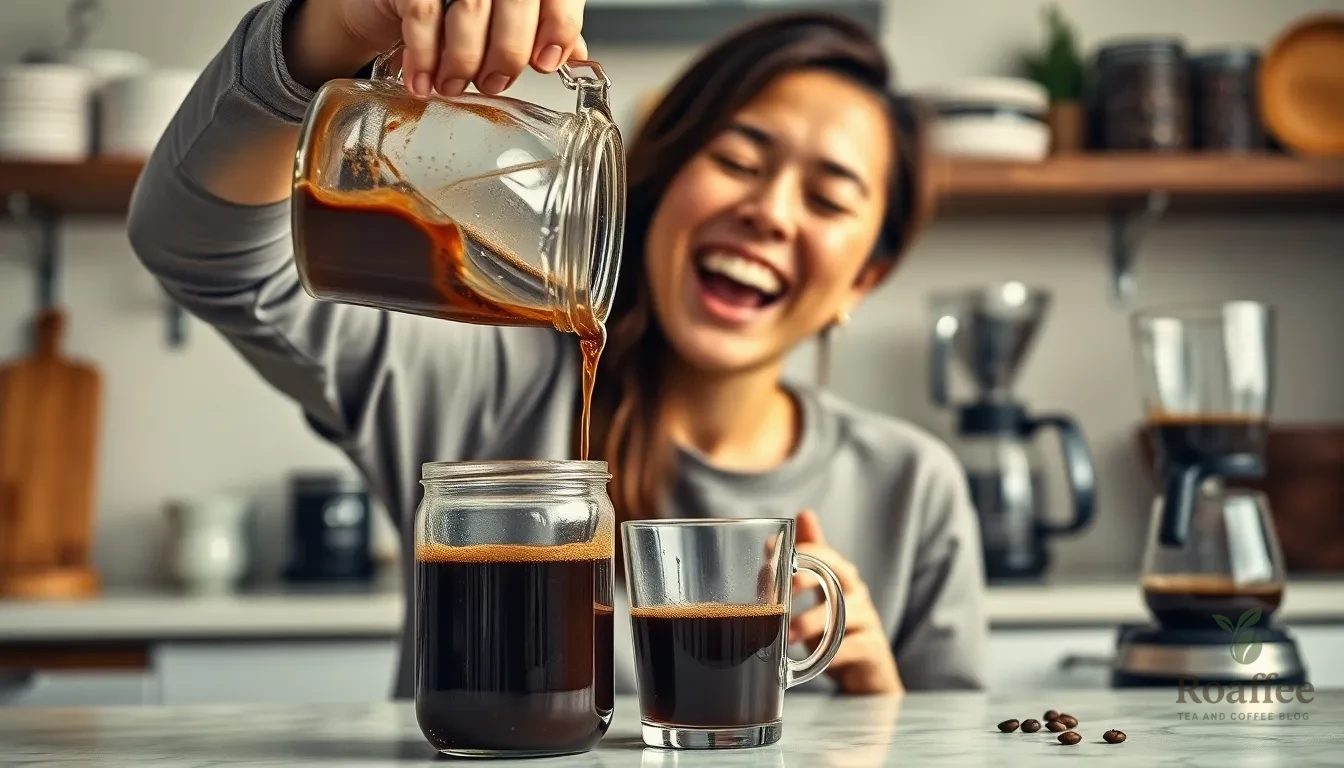
Convenience and Time Savings
Making coffee concentrate at home transforms our daily coffee routine by eliminating the need for daily grinding and brewing. We can prepare our morning cup in seconds by simply diluting the concentrate with hot or cold water. This method proves especially valuable during busy mornings when we need caffeine quickly without compromising on quality.
Serving multiple people becomes effortless when we have concentrate ready in the refrigerator. We no longer need to brew multiple batches or wait for each cup to finish brewing. The concentrate system allows us to customize individual preferences instantly while maintaining consistent quality across all servings.
Cost Effectiveness and Waste Reduction
Brewing coffee concentrate in bulk significantly reduces our coffee expenses compared to purchasing individual servings or expensive coffee shop drinks. We can make large batches at once using common kitchen ingredients without investing in specialized equipment. This approach maximizes our coffee bean usage while minimizing waste from over brewing or discarded coffee.
| Cost Comparison | Traditional Brewing | Coffee Concentrate |
|---|---|---|
| Daily preparation time | 5-10 minutes | 30 seconds |
| Coffee waste | Common | Minimal |
| Batch size | Single serving | Multiple servings |
| Storage duration | Same day | 1-3 weeks |
Versatility in Applications
Coffee concentrate serves as the foundation for countless beverage variations. We can create hot coffee by adding warm water or milk, make iced coffee with cold additions, or create specialty lattes with steamed milk. The concentrate also works exceptionally well in baking recipes, desserts, marinades, and cocktails where intense coffee flavor is desired.
Temperature flexibility sets concentrate apart from traditional brewing methods. We can serve it hot or cold without losing flavor integrity or requiring separate brewing processes. This adaptability makes it perfect for seasonal transitions and varying weather preferences.
Consistent Quality and Flavor Control
Cold brew concentrate delivers remarkably consistent results compared to traditional brewing methods that can vary based on water temperature, timing, and extraction variables. We achieve controlled extraction through the extended steeping process, which reduces acidity and bitterness while maximizing flavor compounds.
The concentrate method eliminates common brewing mistakes like over extraction or uneven saturation. We can replicate the exact same flavor profile batch after batch by following the simple ratio of coffee grounds to water. This consistency proves invaluable for coffee enthusiasts who demand reliable results from their home brewing setup.
Reduced Daily Labor and Effort
Preparing coffee concentrate requires minimal daily involvement once we complete the initial brewing process. We spend 18 to 24 hours allowing the coffee to steep naturally rather than actively monitoring brewing variables. This hands off approach frees up our time while still producing exceptional coffee quality.
The reduced labor benefits extend beyond home use to commercial applications where coffee shops rely on concentrate to maintain speed and quality during peak hours. We can apply these same efficiency principles in our home kitchen to streamline our coffee preparation process.
Equipment Needed

Making coffee concentrate requires minimal equipment that most home kitchens already contain. We designed this list to help you gather everything necessary for a successful cold brew process without investing in expensive specialty gear.
Essential Equipment:
- Coffee grinder (burr or manual) – Essential for achieving the coarse grind consistency that prevents over-extraction
- Coffee scale or kitchen scale – Provides precise measurements for consistent results every batch
- Large jar, pitcher, French press, or Chemex – Serves as your primary brewing vessel for steeping
- Fine mesh sieve or strainer – Separates grounds from liquid during the filtering process
- Coffee filters, nut milk bag, or cheesecloth – Creates the final filtration layer for clear concentrate
- Large container or glass bottles – Stores your finished concentrate in the refrigerator
Why Each Item Matters:
A quality grinder ensures uniform particle size for optimal extraction. We recommend burr grinders over blade grinders because they produce more consistent coarse grounds that resemble flaky sea salt texture. Kitchen scales eliminate guesswork and deliver repeatable results using precise coffee-to-water ratios.
Your brewing vessel should accommodate the full batch size comfortably. French presses simplify the process by combining steeping and initial filtering in one tool. Glass containers work best for storage since they preserve flavor integrity and allow you to monitor concentrate levels easily.
The filtration system requires multiple layers to achieve clarity. Fine mesh strainers catch larger particles while coffee filters or cheesecloth remove sediment for smooth concentrate. This dual-filtration approach can take up to an hour but produces professional-quality results.
Most home brewers already own these basic tools. We avoid recommending expensive equipment because coffee concentrate success depends more on technique and timing than specialized gear.
Ingredients
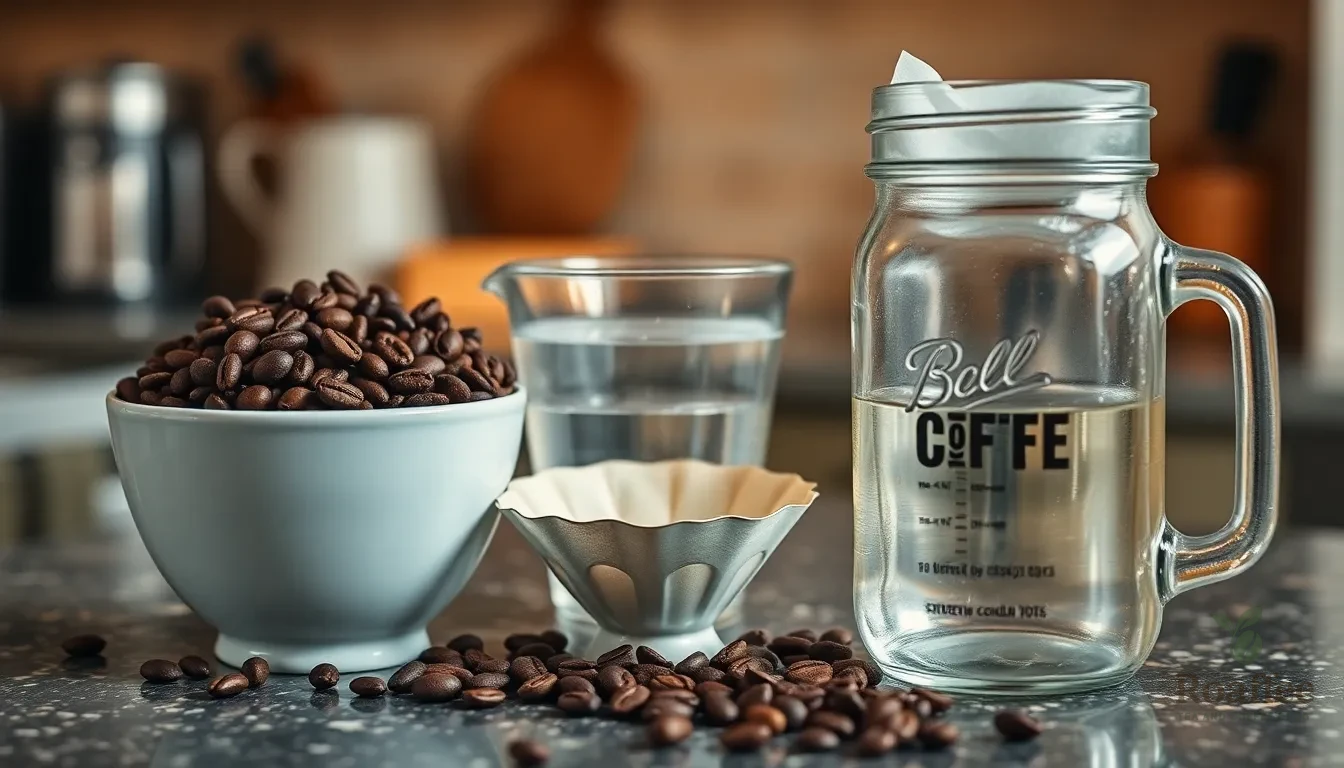
Creating perfect coffee concentrate requires just a few high-quality ingredients that work together to produce a smooth, flavorful result. We keep our ingredient list simple to ensure you can make this concentrate with items readily available in most kitchens.
Essential Ingredients:
- 8 ounces (230 grams) coarsely ground coffee beans – High-quality beans ground to a flaky sea salt consistency prevent over-extraction and bitterness
- 5 cups cold, filtered water – Essential for achieving a crisp and clean flavor profile
- Coffee filter papers or fine mesh strainer – Required for proper filtration and clarity
Coffee Bean Selection:
We recommend using freshly roasted coffee beans that suit your taste preferences. Medium to dark roasts work exceptionally well for concentrate preparation because they provide robust flavors that shine through dilution. The coarse grind size is crucial for preventing over-extraction during the extended steeping process.
Water Quality Matters:
Filtered water makes a important difference in the final product’s taste. Tap water with high mineral content or chlorine can interfere with extraction and create off-flavors. We always use cold water specifically because it extracts flavors more slowly and evenly compared to hot water.
Ratio Guidelines:
| Coffee Amount | Water Amount | Concentration Level |
|---|---|---|
| 25 grams | 1 cup | Standard concentrate |
| 8 ounces (230g) | 5 cups | Batch concentrate |
| 1 part coffee | 4 parts water | Strong concentrate |
The beauty of coffee concentrate lies in its simplicity. These basic ingredients transform into a versatile base that serves multiple purposes in your kitchen. We store our finished concentrate in glass bottles or mason jars to maintain freshness and prevent any unwanted flavors from plastic containers.
Instructions
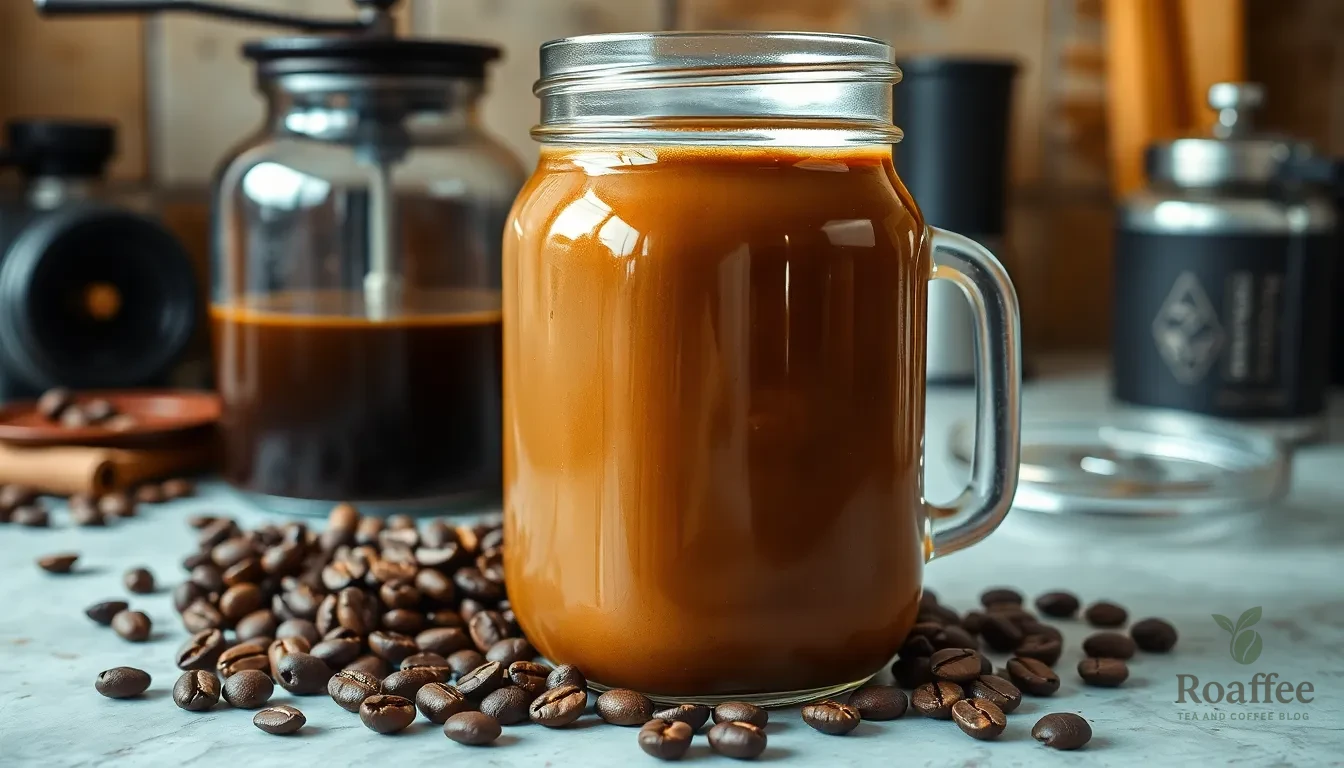
We’ve broken down the coffee concentrate process into five essential steps that guarantee consistent results every time. Following these detailed instructions will help you create a smooth and flavorful concentrate that stays fresh for weeks.
Prep the Coffee Grounds
We start by grinding our coffee beans to a medium to coarse consistency similar to kosher salt. Use approximately 75 grams of coffee grounds for every 3 cups (710 ml) of filtered water. The grinding should be even throughout to ensure proper extraction without over-extraction that can lead to bitterness. We recommend measuring by weight rather than volume for the most accurate results.
Combine Coffee and Water
Place the coffee grounds in a large jar, pitcher, or container that can hold both the coffee and water comfortably. Pour the filtered water over the grounds slowly and evenly. Stir the mixture well to saturate all the coffee grounds completely. We typically use a 1:4 ratio of coffee to water, though you can adjust this to 1:3 for stronger concentrate or 1:5 for a milder version based on your preference.
Steep the Mixture
Seal the container tightly and let the mixture steep for 12 to 24 hours. We find that 16 to 18 hours provides the most balanced extraction. You can steep the mixture either in the refrigerator or at room temperature. This slow brewing process reduces acidity and bitterness while maximizing flavor extraction from the coffee grounds.
Strain the Concentrate
Filter the mixture through a fine mesh strainer lined with a nut milk bag, cheesecloth, or coffee filter to remove all the grounds. We often perform a second filtration to ensure complete clarity and smoothness in the final product. The straining process may take up to an hour to fully drip through, so patience is key for the best results.
Store Properly
Transfer the finished coffee concentrate to a clean, airtight container and store it in the refrigerator. The concentrate will stay fresh for up to 7 to 14 days when properly stored. When serving, we recommend diluting the concentrate with water, milk, or cream using approximately 1 part concentrate to 2 parts liquid, adjusting to taste preferences.
Cold Brew Coffee Concentrate Method
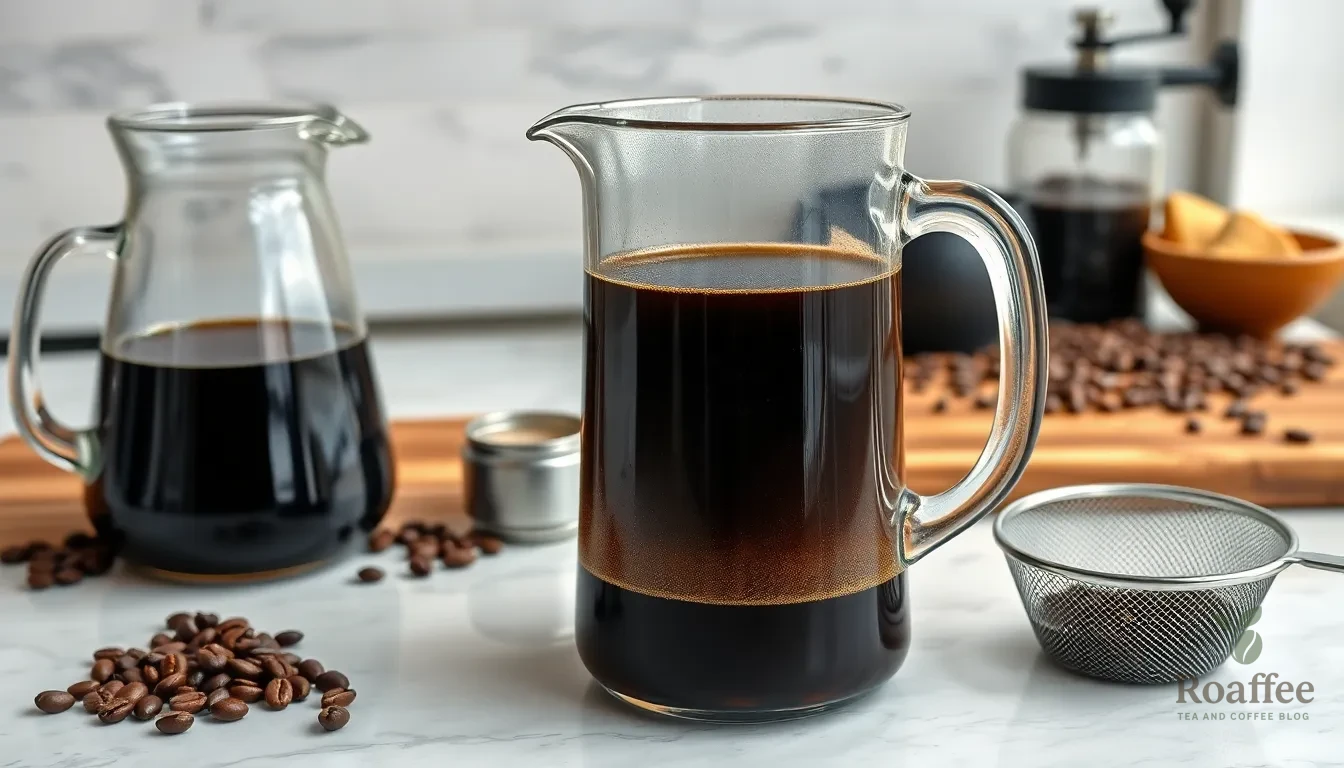
Our cold brew method creates a smooth concentrate through three essential phases: preparation, steeping, and straining. This technique produces a versatile coffee base that delivers consistent results every time.
Cold Brew Prep
We begin by measuring 3/4 cup (approximately 75 grams) of medium-coarse ground coffee for every 3 to 6 cups of cold filtered water, depending on our desired strength. Fresh grinding delivers the best flavor extraction, so we recommend grinding beans just before brewing. The coffee-to-water ratio typically ranges from 1:8 for concentrate, which allows for proper dilution later.
Our grounds need complete saturation for even extraction. We combine the coffee grounds with cold filtered water in a large pitcher, jar, or French press. Stirring thoroughly ensures all grounds become fully saturated and prevents dry pockets that could lead to uneven brewing.
Cold Brew Steeping Process
We cover our mixture and allow it to steep for 12 to 18 hours at room temperature or in the refrigerator. Room temperature steeping produces a stronger brew with more pronounced flavors. Refrigeration slows the extraction process but creates smoother, more mellow flavors with reduced acidity.
The extended steeping time allows for complete extraction of coffee compounds without the heat that typically creates bitterness. We avoid stirring during this phase to prevent over-extraction and maintain the gentle brewing process that cold brew is known for.
Cold Brew Straining
After steeping, we strain our coffee concentrate to remove all grounds for a clean, grit-free result. We pour the mixture through a fine mesh sieve lined with cheesecloth, nut milk bag, or paper filters. This filtration system captures even the finest particles that could make our concentrate cloudy.
For extra clarity, we recommend double straining through fresh filters. French press users simply press the plunger down slowly to separate grounds from liquid. The final concentrate should be smooth and clear, ready for storage in the refrigerator for up to one week.
| Brewing Specification | Measurement |
|---|---|
| Coffee Amount | 75 grams (3/4 cup) |
| Water Volume | 3-6 cups |
| Coffee-to-Water Ratio | 1:8 |
| Steeping Time | 12-18 hours |
| Storage Duration | Up to 1 week |
Hot Brew Coffee Concentrate Method
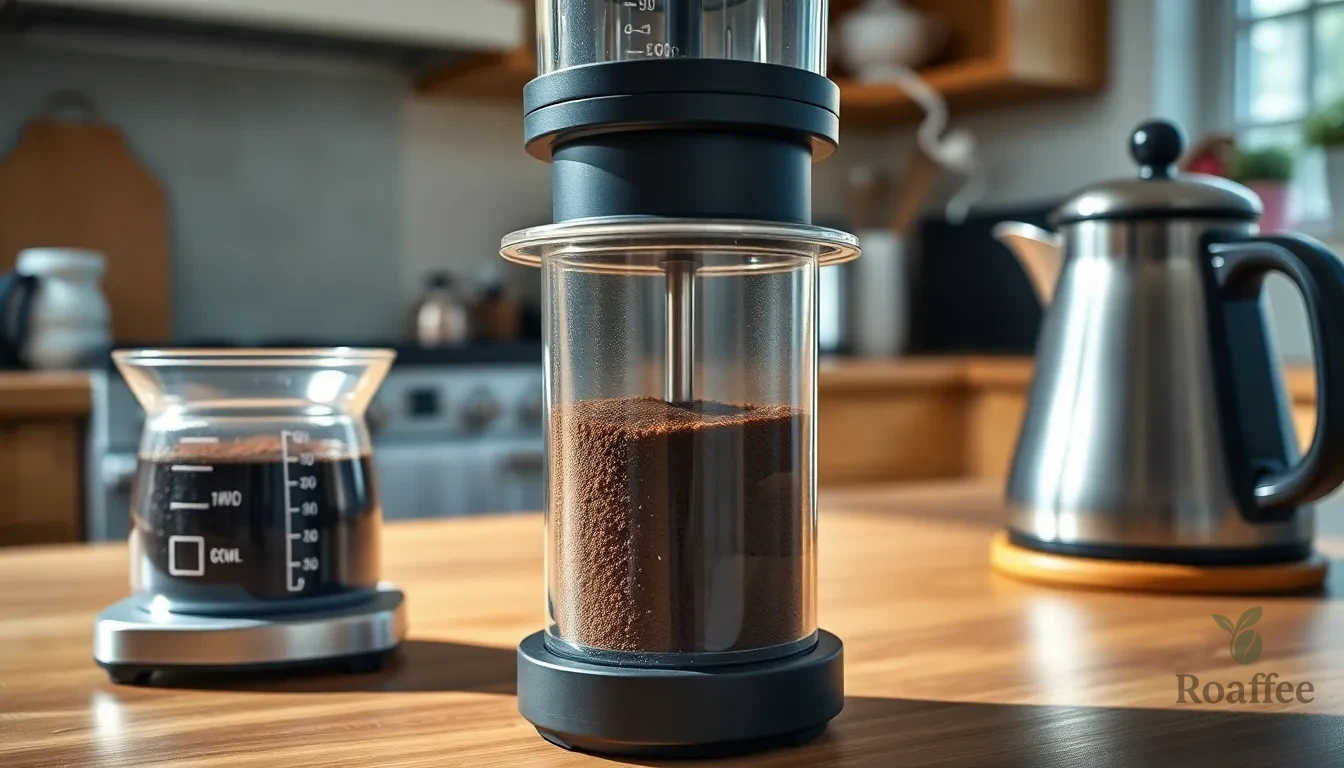
The hot brew method offers a faster alternative to cold brewing while still producing excellent concentrate. This technique uses heated water to extract flavors quickly and efficiently.
Hot Brew Preparation
We start by gathering 30 grams of medium-coarse ground coffee and 200-210 ml of hot water heated to 185-190°F. Place the coffee grounds in an AeroPress and ensure your timer is ready for precise timing.
Pour 120 grams of the hot water over the coffee grounds and start your timer immediately. Stir the mixture continuously for the first 40 seconds to ensure even saturation and extraction. At exactly 1 minute flip the AeroPress and plunge steadily for 20 seconds into a clean cup.
Add 80 grams of hot water to the concentrate and taste the strength. Adjust by adding 5 to 10 grams more water in small increments until you reach your preferred concentration level. This method allows for immediate customization based on your taste preferences.
Hot Brew Cooling Process
The freshly brewed concentrate can be consumed immediately as hot coffee or transformed into iced coffee through proper cooling. Transfer the hot concentrate to a heat-resistant container if you plan to cool it for later use.
For iced coffee applications allow the concentrate to cool to room temperature before refrigerating. This prevents thermal shock and maintains the concentrate’s flavor integrity. Store the cooled concentrate in the refrigerator where it will maintain quality for several days.
The hot brew method provides immediate gratification while offering the same versatility as cold brew concentrate. Use this concentrate as a base for both hot and cold coffee beverages by diluting with water milk or cream according to your taste preferences.
Storage and Shelf Life
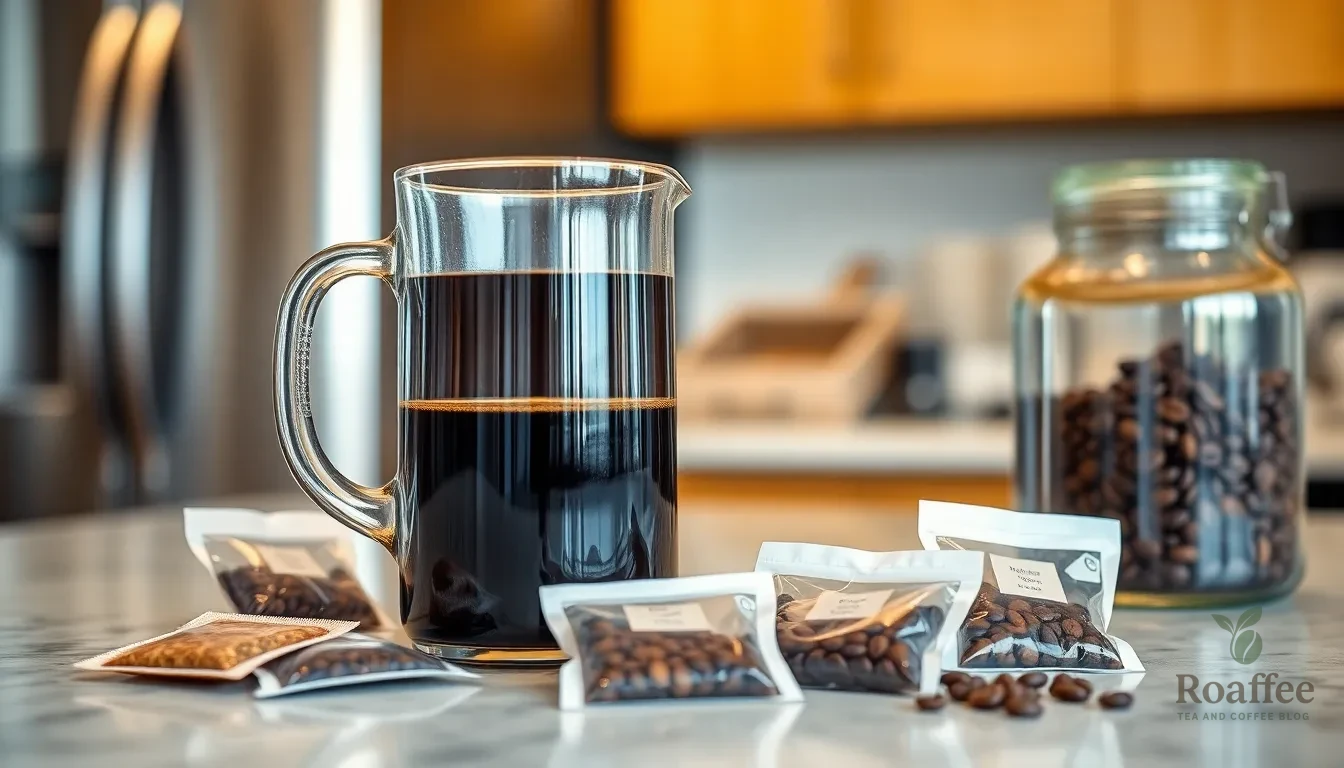
Our coffee concentrate deserves proper storage to maintain its rich flavor and potency. We recommend storing your freshly made concentrate in an airtight glass container in the refrigerator immediately after straining. Glass containers work best because they prevent flavor absorption and protect the concentrate from light exposure.
Optimal Storage Conditions
We keep our coffee concentrate away from three main enemies: light, heat, and air exposure. Store the container in the main body of your refrigerator rather than the door to maintain consistent temperature. The ideal storage temperature ranges between 35°F and 40°F for maximum freshness preservation.
Shelf Life Guidelines
| Storage Method | Shelf Life | Notes |
|---|---|---|
| Refrigerated (opened) | Up to 2 weeks | Best quality maintained |
| Refrigerated (unopened commercial) | Up to 180 days | Varies by brand |
| Room temperature | Not recommended | Rapid deterioration |
| Frozen | Not recommended | Affects flavor and texture |
Our homemade coffee concentrate maintains peak quality for up to two weeks when stored properly in the refrigerator. We notice the flavor begins to deteriorate after this period though the concentrate remains safe to consume. Commercial concentrates may last longer due to specialized packaging and preservation methods.
Equipment Sanitation
We always use clean and sanitized equipment when preparing coffee concentrate to prevent contamination. Filtered water during the brewing process also helps extend shelf life by reducing impurities that could affect flavor. Wash all containers with hot soapy water and rinse thoroughly before storing your concentrate.
Signs of Spoilage
We check our coffee concentrate regularly for any off odors, mold growth, or unusual texture changes. Fresh concentrate should smell rich and coffee-like without any sour or fermented notes. Discard the concentrate immediately if you notice any signs of spoilage or if it has been stored longer than two weeks.
How to Use Coffee Concentrate
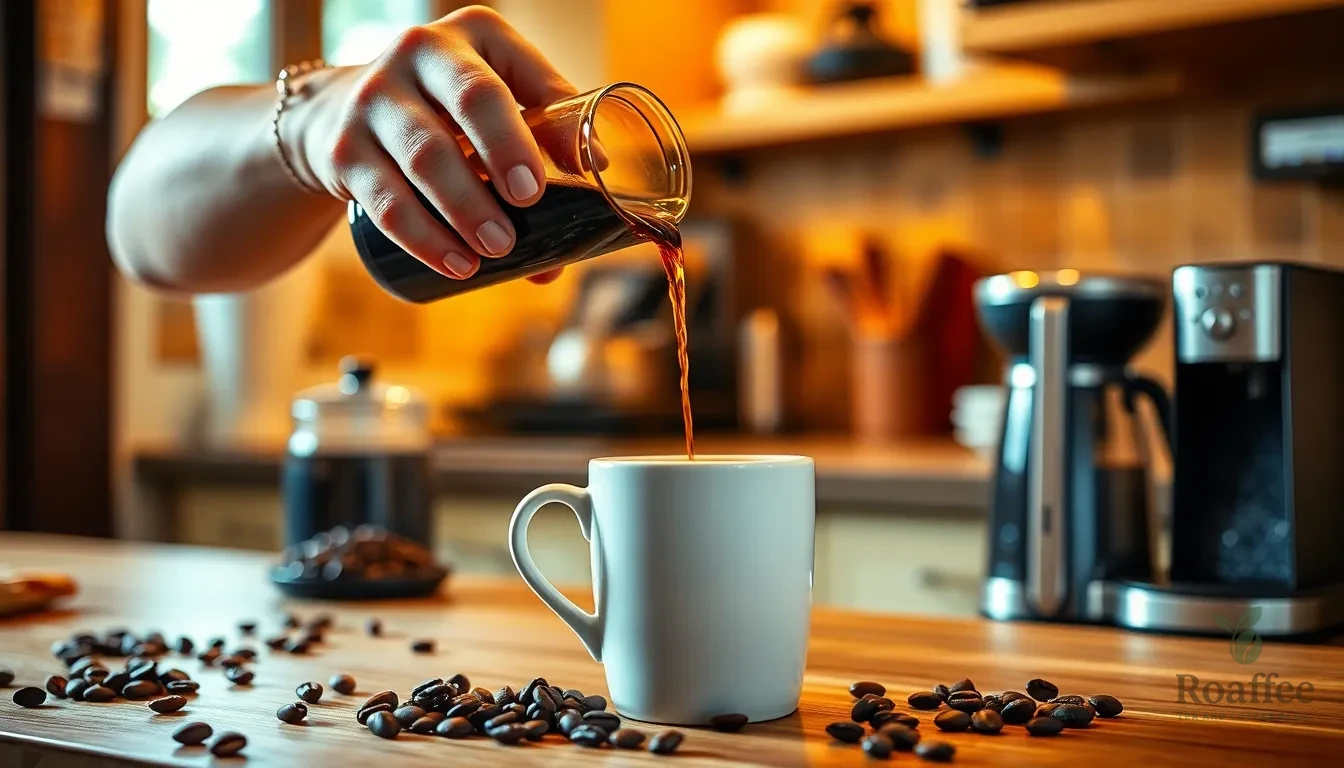
Now that you have your freshly made coffee concentrate, we can transform it into various delicious beverages. The beauty of coffee concentrate lies in its versatility and the ability to customize each cup to your exact taste preferences.
Making Hot Coffee
We recommend starting with a 1:1 ratio of coffee concentrate to hot water for a balanced flavor. Pour equal parts concentrate and hot water into your mug, then stir gently to combine. The hot water should be around 200°F to maintain the concentrate’s smooth flavor profile without creating bitterness.
For a stronger cup, we suggest using a 2:1 ratio of concentrate to water. Those who prefer a milder taste can dilute further with additional hot water. Adding milk or cream enhances the richness and creates a coffeehouse-style experience at home.
We find that preheating your mug with hot water before adding the concentrate helps maintain the optimal drinking temperature longer. This simple step ensures your coffee stays warm throughout your morning routine.
Making Iced Coffee
Creating perfect iced coffee starts with filling a tall glass with ice cubes. We pour 1 to 2 shots of coffee concentrate directly over the ice, depending on your preferred strength. The concentrate should be cold from refrigerator storage for the best results.
Cold milk or water can be added to reach your desired taste and consistency. We recommend starting with equal parts concentrate and cold liquid, then adjusting to taste. Sweeteners blend more easily when added before the final stir.
For an extra refreshing twist, we suggest freezing some concentrate in ice cube trays. These coffee ice cubes prevent dilution while maintaining the bold flavor as they melt. A final stir ensures all ingredients are well combined before serving.
Coffee Concentrate Recipes
Our favorite frozen coffee treat combines concentrate, ice, milk, and optional sweetener in a blender until slushy. This creates a café-quality frappé that rivals expensive coffee shop versions. Serve immediately in a tall glass with a straw for the best experience.
We also use coffee concentrate as a base for coffee cocktails and dessert recipes. The concentrated flavor holds up well when mixed with spirits like whiskey or rum. For baking applications, we substitute concentrate for regular coffee in recipes requiring liquid coffee.
Coffee concentrate ratios can be adjusted based on your brewing preferences. We’ve found that steeping 1.3 cups of coffee grounds with 6.7 cups of water for 8 to 24 hours in the refrigerator creates a versatile concentrate. This ratio works well for both hot and cold applications while maintaining consistent flavor strength.
Troubleshooting Tips
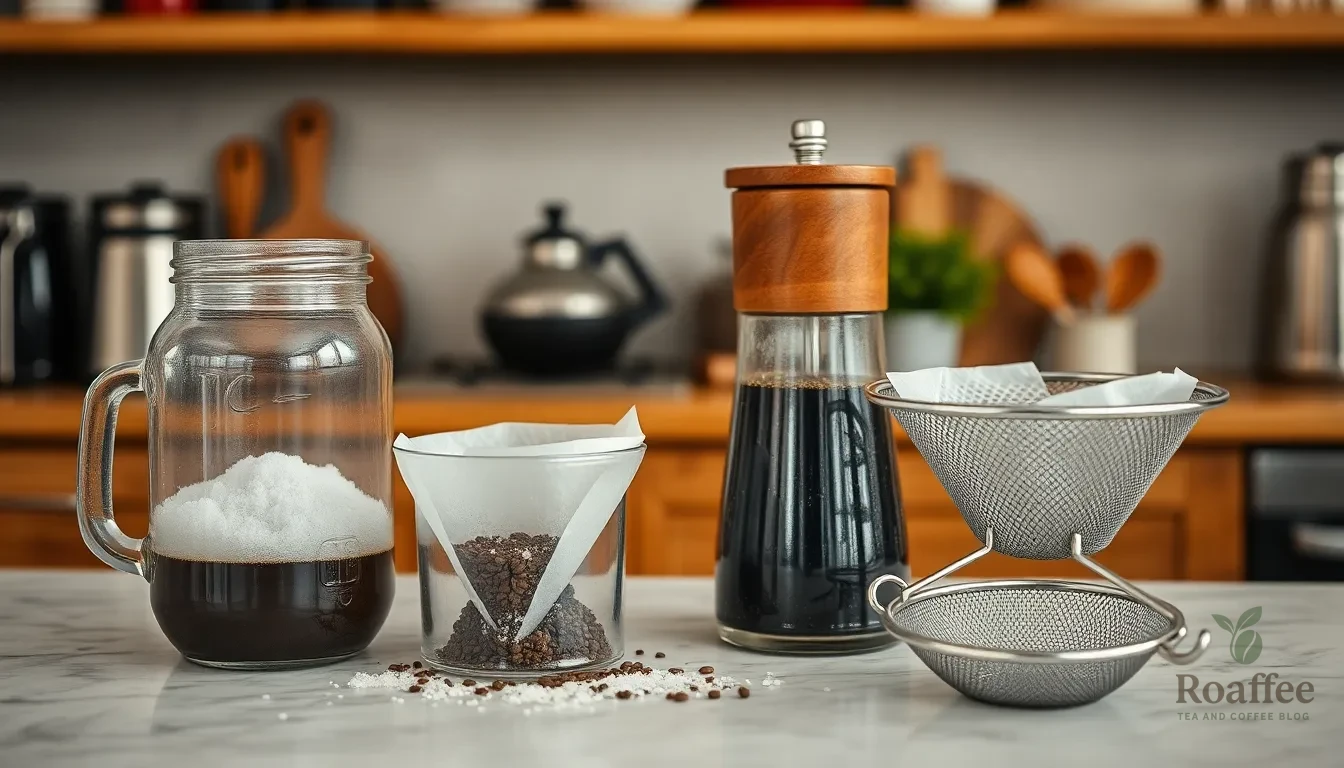
Even experienced coffee enthusiasts encounter challenges when making coffee concentrate. We’ve compiled the most common issues and their answers to help you achieve perfect results every time.
Brewing Time Adjustments
Start with 16 to 18 hours for your initial brewing attempts. This timeframe allows proper extraction without over-processing the coffee grounds. We recommend extending the steeping period gradually if you prefer a smoother and sweeter taste profile. Never exceed 24 hours as this can introduce unwanted bitterness and harsh flavors to your concentrate.
Achieving Proper Filtration
Double-strain your concentrate using a coffee filter to eliminate sediment and create a smoother texture. First strain through a coarse mesh to remove large particles. Follow this with a fine coffee filter to capture remaining grounds and oils. This dual-filtration approach ensures clarity and prevents gritty residue in your final product.
Grind Size Optimization
Use a coarse grind similar to sea salt or breadcrumbs to prevent over-extraction. Fine grounds create excessive bitterness and make filtration extremely difficult. A coarse grind also allows water to circulate freely around the coffee particles during the long steeping process. This grind size reduces clogging in your filtration system and produces cleaner concentrate.
Strength and Dilution Issues
Adjust your coffee-to-water ratio if your concentrate tastes too weak or overpowering. For stronger concentrate increase the coffee amount rather than extending brewing time. Weak concentrate typically results from insufficient coffee grounds or poor saturation during the initial mixing phase. Always stir thoroughly to ensure all grounds are completely saturated before beginning the steeping process.
Storage and Freshness Problems
Store your concentrate in airtight glass containers immediately after filtration to prevent oxidation and flavor degradation. Keep the container in the main body of your refrigerator away from strong odors and temperature fluctuations. Fresh concentrate should maintain its robust flavor for up to two weeks when stored properly. Discard any concentrate that develops off-flavors or shows signs of mold growth.
Conclusion
Coffee concentrate transforms your daily coffee routine into something effortless and enjoyable. We’ve shown you how this simple brewing method delivers consistent results while saving time and money.
Whether you choose the cold brew method for smoothness or the hot brew technique for speed both approaches give you weeks of delicious coffee ready at a moment’s notice. Your concentrate becomes the foundation for countless beverages from morning cups to evening cocktails.
The beauty lies in its simplicity – coarse grounds water time and proper storage create a versatile ingredient that elevates your entire coffee experience. Start brewing your first batch today and discover why coffee concentrate has become our go-to solution for better coffee every time.
Frequently Asked Questions
What is coffee concentrate?
Coffee concentrate is a highly concentrated liquid coffee extract made by steeping coarsely ground coffee beans in water for 12-24 hours using a higher coffee-to-water ratio (1:4 to 1:8). This cold brewing method reduces acidity and bitterness while maximizing flavor extraction, creating a potent solution that can be diluted with water, milk, or cream.
How long does coffee concentrate last?
Homemade coffee concentrate can be stored in the refrigerator for up to 2-3 weeks when kept in an airtight glass container. Commercial unopened concentrates can last up to 180 days. Store it in the main body of the refrigerator, away from light, heat, and air exposure to maintain optimal freshness and flavor.
What equipment do I need to make coffee concentrate?
You need minimal equipment: a coffee grinder for coarse grinding, a kitchen scale for precise measurements, a brewing vessel (French press or large jar), a fine mesh sieve for filtering, and glass storage containers. Most of these items are already found in home kitchens, making coffee concentrate accessible without expensive equipment.
What’s the difference between hot and cold brew concentrate?
Cold brew concentrate uses room temperature water and steeps for 12-24 hours, resulting in smoother, less acidic coffee. Hot brew concentrate uses heated water (200-210°F) and extracts flavors quickly within minutes. Both methods create versatile concentrates, but hot brewing offers immediate results while cold brewing provides mellower flavors.
How do I use coffee concentrate to make different drinks?
For hot coffee, mix concentrate with hot water in a 1:1 ratio. For iced coffee, pour concentrate over ice and dilute with cold water or milk. You can adjust strength by changing the dilution ratio. Coffee concentrate also works well in cocktails, baking recipes, and frozen coffee treats.
What coffee-to-water ratio should I use?
Use approximately 75 grams of coarsely ground coffee for every 3 cups (24 oz) of filtered water. This creates a strong concentrate that can be diluted to taste. For different strength preferences, you can adjust the ratio between 1:4 to 1:8 (coffee to water) depending on your desired concentration level.
How do I know if my coffee concentrate has gone bad?
Signs of spoilage include sour or off odors, visible mold growth, cloudy appearance, or unusual taste. Fresh concentrate should smell rich and coffee-like with a clear, dark appearance. If you notice any of these warning signs, discard the concentrate immediately. Proper storage and sanitation help prevent contamination.
Can I make coffee concentrate without special equipment?
Yes! You can make coffee concentrate using basic kitchen items like a large jar for steeping, a fine mesh strainer or cheesecloth for filtering, and any airtight container for storage. While specialized equipment like a French press makes the process easier, it’s not required for successful concentrate preparation.

